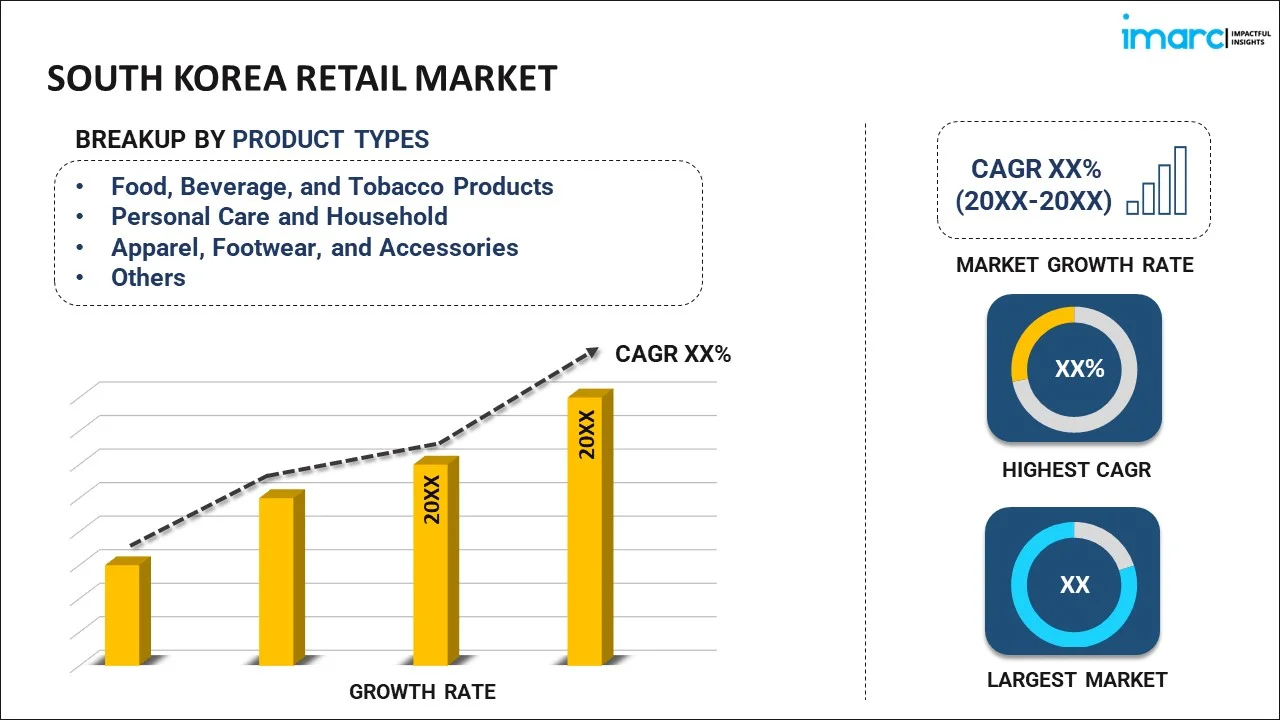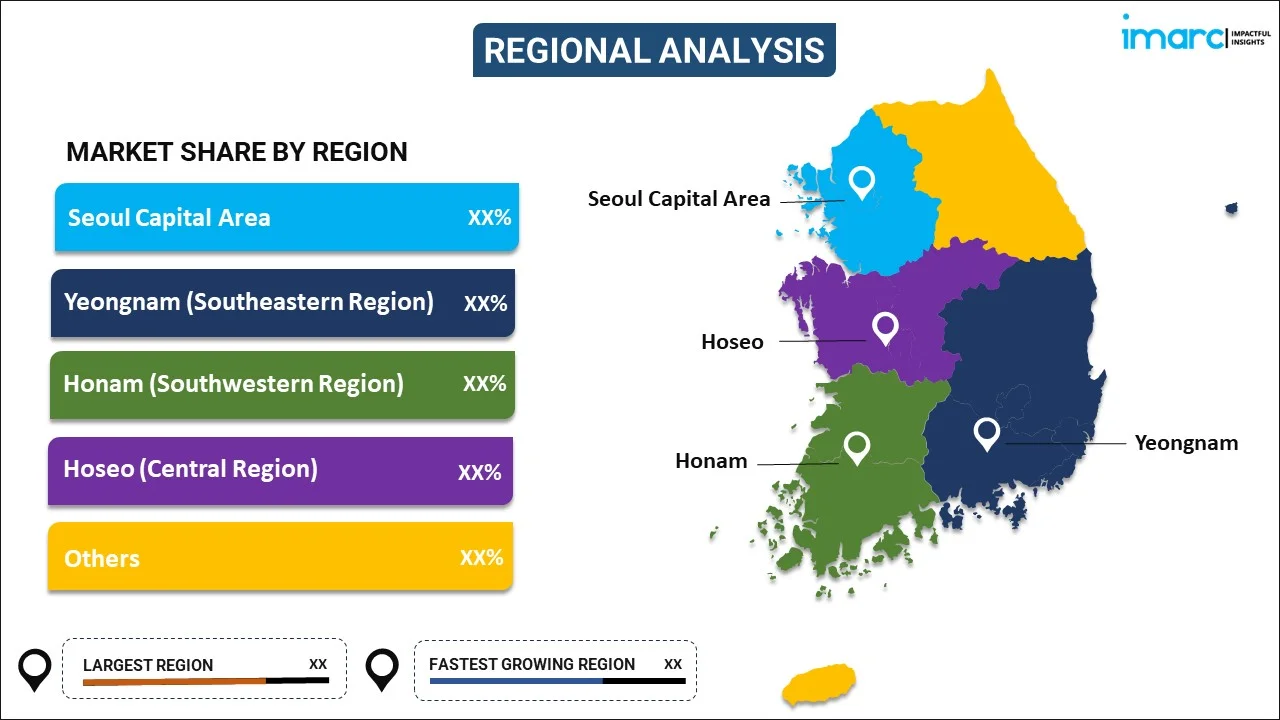
South Korea Retail Market Report by Product Type (Food, Beverage, and Tobacco Products, Personal Care and Household, Apparel, Footwear, and Accessories, Furniture, Toys, and Hobby, Industrial and Automotive, Electronic and Household Appliances, Pharmaceuticals, Luxury Goods, and Others), Distribution Channel (Hypermarkets and Supermarkets, Convenience Stores, Department Stores, Specialty Stores, Online, and Others), and Region 2025-2033
Market Overview:
South Korea retail market size reached USD 400.0 Million in 2024. Looking forward, IMARC Group expects the market to reach USD 820.0 Million by 2033, exhibiting a growth rate (CAGR) of 7.4% during 2025-2033. Rapid technological advancements in e-commerce and mobile payment solutions, changing consumer preferences, increasing sales of premium and imported products, and rising influence of K-pop and Korean dramas represent some of the key factors driving the market.
|
Report Attribute
|
Key Statistics
|
|---|---|
|
Base Year
|
2024 |
|
Forecast Years
|
2025-2033
|
|
Historical Years
|
2019-2024
|
| Market Size in 2024 | USD 400.0 Million |
| Market Forecast in 2033 | USD 820.0 Million |
| Market Growth Rate (2025-2033) | 7.4% |
Retail is the process through which goods and services are sold directly to the end consumer for personal use. This sector encompasses a wide range of businesses, from brick-and-mortar stores to online platforms. The retail industry is continuously adapting to consumer behaviors and technological advancements. In particular, e-commerce is experiencing significant growth owing to the increased accessibility and convenience of online shopping. Moreover, the emergence of omnichannel retailing is blending digital and physical shopping experiences, aiming to offer more personalized and seamless customer interactions. Retailers are increasingly utilizing data analytics to make informed decisions about inventory management, pricing strategies, and customer engagement. At the same time, consumer expectations are rising, emphasizing the importance of quality service, product availability, and the overall shopping experience. Amid global challenges like supply chain disruptions and economic fluctuations, the retail industry is striving to be more resilient and agile. With sustainability and social responsibility becoming pivotal considerations, many retailers are adopting eco-friendly practices and ethical sourcing. As a result, retail is a complex, evolving ecosystem that significantly impacts both the economy and society.
South Korea Retail Market Trends:
The South Korea retail market is currently driven by a multitude of factors that reflect both local trends and global influences. One of the most significant drivers is technological innovation, particularly in e-commerce and mobile payment solutions. South Koreans are avid users of technology, and the adoption rate of smartphones is among the highest globally. This has facilitated the rapid growth of online shopping, especially as faster internet speeds and secure payment platforms become more prevalent. Besides this, the country’s sophisticated logistics infrastructure supports quick deliveries and efficient customer service, further propelling the growth of the digital retail landscape. Additionally, consumer behavior is also undergoing substantial changes. The younger generation, heavily influenced by Western culture and lifestyle, is showing a growing preference for quality over quantity, further catalyzing the demand for premium and imported products. This has paved the way for the proliferation of specialty stores and international brands in the market. There is also a noticeable shift toward health and wellness, which is accelerating the sales of organic products, fitness gear, and wellness services. Moreover, Korean retailers are embracing an omnichannel approach to engage consumers across multiple touchpoints, integrating online and offline retail experiences to enhance customer satisfaction. In line with this, the influence of K-pop and Korean dramas is leveraging the country’s soft power to boost retail exports, including cosmetics, fashion, and entertainment products, thus fostering market growth. Furthermore, various favorable government policies and economic conditions, such as free trade agreements that facilitate a more straightforward import of goods, are diversifying the retail product range available to consumers, thereby contributing to market growth. Other factors, including strong domestic consumption, an increasingly affluent and sophisticated consumer base, and rising cultural influences, are also anticipated to stimulate market growth.
South Korea Retail Market Segmentation:
IMARC Group provides an analysis of the key trends in each segment of the market, along with forecasts at the country level for 2025-2033. Our report has categorized the market based on product type and distribution channel.
Product Type Insights:

- Food, Beverage, and Tobacco Products
- Personal Care and Household
- Apparel, Footwear, and Accessories
- Furniture, Toys, and Hobby
- Industrial and Automotive
- Electronic and Household Appliances
- Pharmaceuticals, Luxury Goods
- Others
The report has provided a detailed breakup and analysis of the market based on the product type. This includes food, beverage, and tobacco products, personal care and household, apparel, footwear, and accessories, furniture, toys, and hobby, industrial and automotive, electronic and household appliances, and pharmaceuticals, luxury goods, and others.
Distribution Channel Insights:
- Hypermarkets and Supermarkets
- Convenience Stores
- Department Stores
- Specialty Stores
- Online
- Others
A detailed breakup and analysis of the market based on the distribution channel have also been provided in the report. This includes hypermarkets and supermarkets, convenience stores, department stores, specialty stores, online, and others.
Regional Insights:

- Seoul Capital Area
- Yeongnam (Southeastern Region)
- Honam (Southwestern Region)
- Hoseo (Central Region)
- Others
The report has also provided a comprehensive analysis of all the major regional markets, which include Seoul Capital Area, Yeongnam (Southeastern Region), Honam (Southwestern Region), Hoseo (Central Region), and others.
Competitive Landscape:
The market research report has also provided a comprehensive analysis of the competitive landscape in the market. Competitive analysis such as market structure, key player positioning, top winning strategies, competitive dashboard, and company evaluation quadrant has been covered in the report. Also, detailed profiles of all major companies have been provided.
South Korea Retail Market Report Coverage:
| Report Features | Details |
|---|---|
| Base Year of the Analysis | 2024 |
| Historical Period | 2019-2024 |
| Forecast Period | 2025-2033 |
| Units | Million USD |
| Scope of the Report | Exploration of Historical and Forecast Trends, Industry Catalysts and Challenges, Segment-Wise Historical and Predictive Market Assessment:
|
| Product Types Covered | Food, Beverage, and Tobacco Products, Personal Care and Household, Apparel, Footwear, and Accessories, Furniture, Toys, and Hobby, Industrial and Automotive, Electronic and Household Appliances, Pharmaceuticals, Luxury Goods, Others |
| Distribution Channels Covered | Hypermarkets and Supermarkets, Convenience Stores, Department Stores, Specialty Stores, Online, Others |
| Regions Covered | Seoul Capital Area, Yeongnam (Southeastern Region), Honam (Southwestern Region), Hoseo (Central Region), Others |
| Customization Scope | 10% Free Customization |
| Post-Sale Analyst Support | 10-12 Weeks |
| Delivery Format | PDF and Excel through Email (We can also provide the editable version of the report in PPT/Word format on special request) |
Key Questions Answered in This Report:
- How has the South Korea retail market performed so far and how will it perform in the coming years?
- What has been the impact of COVID-19 on the South Korea retail market?
- What is the breakup of the South Korea retail market on the basis of product type?
- What is the breakup of the South Korea retail market on the basis of distribution channel?
- What are the various stages in the value chain of the South Korea retail market?
- What are the key driving factors and challenges in the South Korea retail?
- What is the structure of the South Korea retail market and who are the key players?
- What is the degree of competition in the South Korea retail market?
Key Benefits for Stakeholders:
- IMARC’s industry report offers a comprehensive quantitative analysis of various market segments, historical and current market trends, market forecasts, and dynamics of the South Korea retail market from 2019-2033.
- The research report provides the latest information on the market drivers, challenges, and opportunities in the South Korea retail market.
- Porter's five forces analysis assist stakeholders in assessing the impact of new entrants, competitive rivalry, supplier power, buyer power, and the threat of substitution. It helps stakeholders to analyze the level of competition within the South Korea retail industry and its attractiveness.
- Competitive landscape allows stakeholders to understand their competitive environment and provides an insight into the current positions of key players in the market.
Need more help?
- Speak to our experienced analysts for insights on the current market scenarios.
- Include additional segments and countries to customize the report as per your requirement.
- Gain an unparalleled competitive advantage in your domain by understanding how to utilize the report and positively impacting your operations and revenue.
- For further assistance, please connect with our analysts.
 Inquire Before Buying
Inquire Before Buying
 Speak to an Analyst
Speak to an Analyst
 Request Brochure
Request Brochure
 Request Customization
Request Customization




.webp)




.webp)












